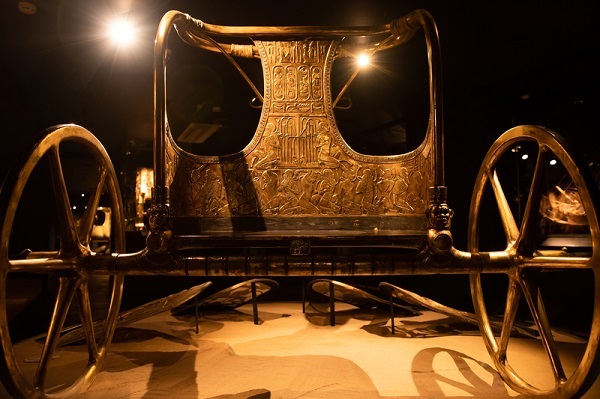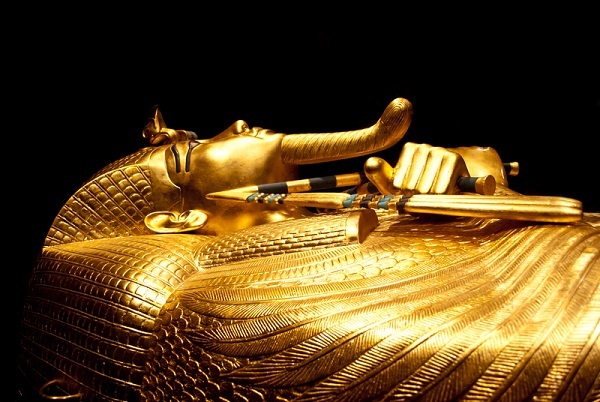

The most well-known Pharaoh of Egypt's New Kingdom, king Tutankhamun, ruled at the end of the Eighteenth Dynasty (reigned 1333–23 BCE). He was buried in the Valley of the Kings as a mummy after he passed away at the age of 18 or 19. His tomb, which Howard Carter found in 1922, is well-known around the world due to its stunning artefacts made out of gold.
Tutankhamun was born in Egypt's late Eighteenth Dynasty, during Akhenaten's rule. An inscription at Hermopolis refers to “Tutankhamun'' as a “king's son” generally of King Akhenaten.
When Tutankhamun was nine years old, he ascended to the throne under the extraordinary vizier ship of his eventual successor, Ay.
Tutankhamun had a deformed left foot and bone necrosis, which rendered him physically disabled and dependent on walking canes. He also had scoliosis and other medical conditions, as well as many malarial strains which may have contributed to his early death.
He is the most well-known Egyptian pharaoh whose demise is still a mystery. Furthermore, he was buried in the Valley of the Kings as a mummy after he passed away at the age of 18 or 19.
Given his position, Tutankhamun's tomb was surprisingly small.
He might have passed very suddenly, before a more magnificent royal tomb was built, leading to his remains being buried in a tomb intended for someone else. This would keep the customary 70-day waiting time before burial in effect.
Because it was hidden by the remnants of other tombs and because the entrance to the tomb had been built over, the location of the tomb was forgotten.
It was rediscovered in 1922 through the systematic effort of Archaeologist Howard Carter from Britain.
Tutankhamun's tomb soon established himself as a representative of Egyptian identity upon his discovery.

Accurate copy of Tutankhamen`s golden ceremonial Chariot . was found in Tutankhamun`s tomb.
The Tutankhamun tomb, which was nearly intact, offered unparalleled insight into this period of Egyptian history. The Tomb of Tutankhamun differs from others in the Valley of the Kings mainly because of the wall decorations.
There were not just one, but three coffins for the king's bones in the stone sarcophagus that housed Tutankhamun's body. The two external coffins were made of wood and decorated with gold and a variety of semi-precious stones, such as lapis lazuli and turquoise. Additionally, just the burial room's walls were decorated.
Scholars say that this tomb wasn't initially designed to guard the remains of kings and that it was hastily modified to do so because of the lack of decoration on its walls.
The Tutankhamun sarcophagus was discovered in the burial chamber, which was also home to four gilded wooden shrines.
The treasure room is a different chamber that contains important items that can be used during and after the burial or symbolic items that the pharaoh would use in the afterlife and that will protect the tomb from evil spirits and thieves.
Tutankhamun's tomb treasures mainly remained in Egypt, unlike other discoveries. Nearly 5,398 objects were discovered in the tomb, and it remains the richest royal collection ever found.
The murals were large and some are painted.
The murals and these artefacts shed information on the monarch of Ancient Egypt's life and demise.
They also gave us significant information on Egypt's political, theological, and spiritual climate throughout his life and after his passing. Also, other objects like a lotus chalice, a gold toe stall, a death mask, thrones, archery bows, trumpets, a gold coffin, furnishings, food, wine, and sandals were found in which the death mask is considered to be a masterpiece of Egyptian art.
Additionally, there are shrines, a wishing cup, a shield, a gliding timber bed, and other artefacts to aid the golden pharaoh in his ascension into the afterlife.

King Tutankhamun’s tomb
Description: Golden coffin of the Egyptian pharaoh Tuthankamon.
Tutankhamun wasn't a particularly notable ruler, but his tomb is the only one that has survived to the present day. This tomb is significant because it gave archaeologists the chance to record and learn about how an Egyptian king's tomb looked and how people were buried back then.
Additionally, it sheds light on the intricate process of preserving mummies, which includes drying the body, removing the brain and digestive system, and embalming the body. As a result, the finding influenced methods and ancient Egyptian architectural and artistic traditions both nationally and internationally.
Tutankhamun was a powerful pharaoh who reinstated the reverence for the gods that his predecessor had downplayed, although he only ruled for a brief period and is not well-represented in history. Because his tomb was so magnificent and comprehensive which reflects ancient Egyptian culture, society, arts and architecture, etc even 3,000 years after his passing, he is still well-known today.
Q1. Why was King Tut's body scanned using CT technology?
Ans. Even by royal standards, the death of King Tut was a significant event, but the circumstances of it and what happened next were obscure. So to provide new information regarding his life and death, a CT scan was performed. The creation of an accurate forensic reconstruction of the young pharaoh was the other goal.
Q2. Why was King Tut's tomb buried with gold and other luxurious treasures?
Ans. The royals of Tut's period were enormously wealthy and believed they could carry their money with them on their journey to the afterlife, therefore he was buried heaped with gold and other luxurious treasures. It also conveys the notion of Egyptian belief in the afterlife.
Q3. Why is Tutankhamun's restoration inscription significant?
Ans. This inscription, written to defend the new king's conduct and portray him as a “legitimate” ruler, has had a significant impact on how Akhenaten's goals have been reconstructed.